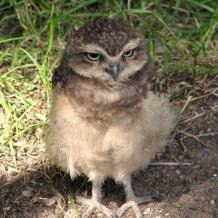Topic: Simple tool use in owls and cephalopods
Burrowing owls place pieces of collected dung. These attract insects such as beetles that are then eaten by the owls.
A number of groups of animals have independently evolved the capacity to use tools, notably to modify their environment or obtain food. Amongst the most spectacular examples are the New World monkeys, dolphins and birds (especially the New Caledonian crow). There is, however, a spectrum of complexity in tool use, from the extraordinarily sophisticated products of the New Caledonian crow to re-arrangement of inanimate objects to achieve a specific function. Here we mention some of the more simple forms of tool use:
 In burrowing owls, for example, the birds place pieces of collected dung. These attract insects such as beetles that are then eaten by the owls. Moving pieces of dung hardly qualifies in most people’s minds as tool use, but if we follow Beck’s definition of 1980 then such manipulation is a valid use of the concept (“Tool use is the external employment of an unattached environmental object to alter more efficiently the form, position, or condition of another object, another organism,
In burrowing owls, for example, the birds place pieces of collected dung. These attract insects such as beetles that are then eaten by the owls. Moving pieces of dung hardly qualifies in most people’s minds as tool use, but if we follow Beck’s definition of 1980 then such manipulation is a valid use of the concept (“Tool use is the external employment of an unattached environmental object to alter more efficiently the form, position, or condition of another object, another organism,  or the user itself when the user holds or carries the tool during or just prior to use and is responsible for the proper and effective orientation of the tool”).
or the user itself when the user holds or carries the tool during or just prior to use and is responsible for the proper and effective orientation of the tool”).
So too in the case of the octopus the deliberate placing of stones, shells and even bits of broken bottle to form a wall that constricts the aperture to the den is a type of tool use. Recently it has been documented that veined octopuses (Amphioctopus marginatus) use discarded coconut shells as a shelter, having retrieved, manipulated, transported and reassembled them.
Cite this web page
Map of Life - "Simple tool use in owls and cephalopods"
https://mapoflife.org/topics/topic_59_simple-tool-use-in-owls-and-cephalopods/
March 4, 2021

